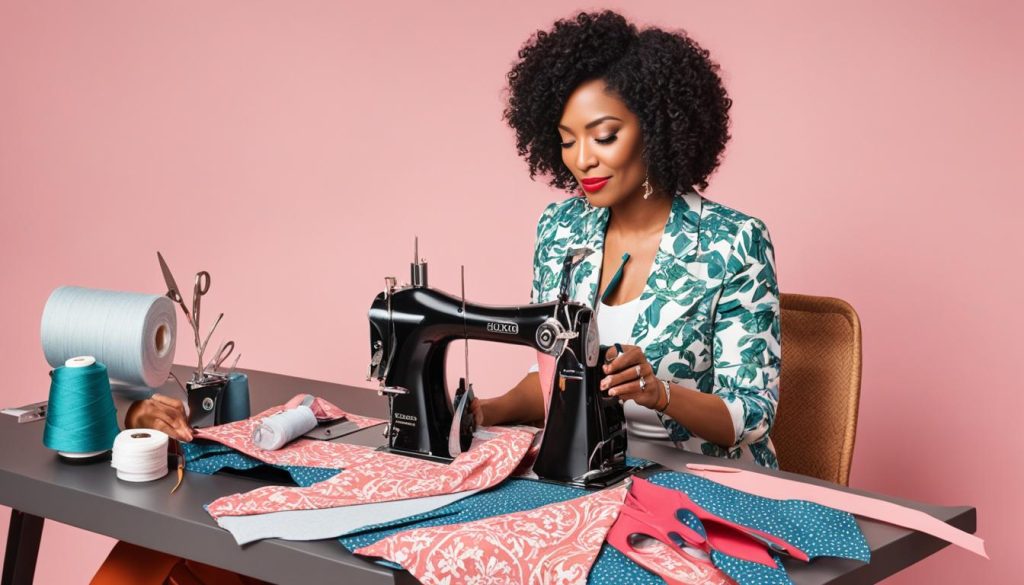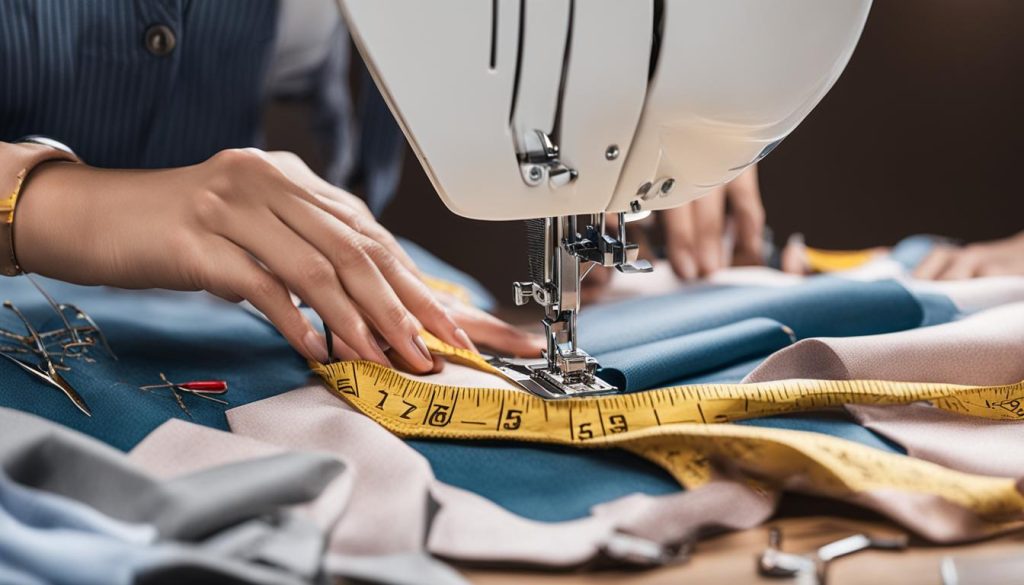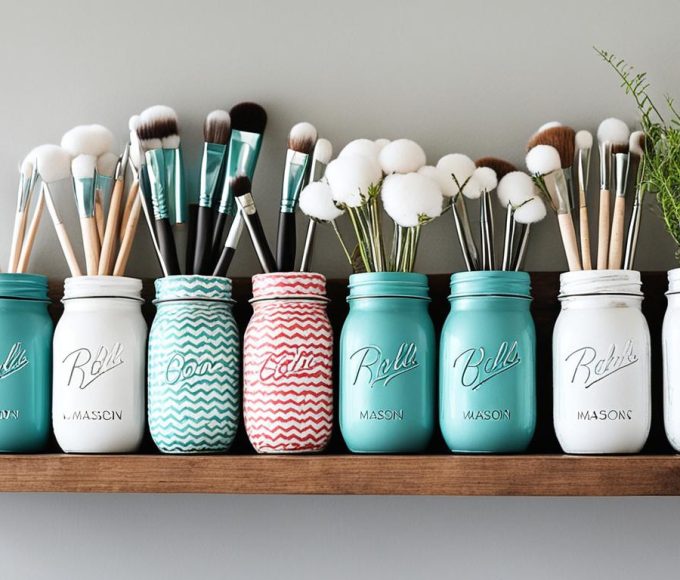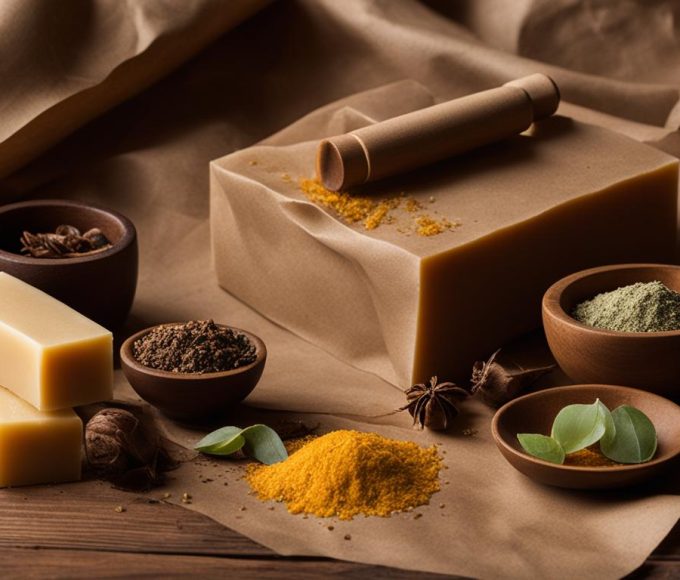Welcome to our beginner-friendly sewing tutorial series! In this article, we’re going to show you how to make easy sewing alterations to your clothes. Whether you’re new to sewing or looking to sharpen your skills, these DIY clothing alterations are perfect for beginners like you.
Why buy new clothes when you can give your existing wardrobe a fresh look? With our step-by-step sewing projects, you’ll be able to alter your clothes to fit you perfectly, without breaking the bank. From shortening hems and adjusting sides to adding sleeves and more, we’ll guide you through the process with simple and easy-to-follow instructions.
Our sewing tutorials are specifically designed for beginners, so you don’t need any prior experience to get started. We’ll cover the basics and provide you with all the essential tips and techniques you need to know. By the end of the series, you’ll be amazed at what you can accomplish with just a few simple sewing alterations.
So, if you’re ready to unleash your creativity and transform your wardrobe, let’s dive in! Get your sewing machine ready and prepare to become a DIY clothing alterations pro. Stay tuned for our upcoming articles, where we’ll walk you through each alteration step by step.
Understanding the Importance of Clothing Alterations
Clothing is often made with a standard body shape in mind, which may not necessarily match everyone’s measurements. That’s where clothing alterations come in. By learning simple sewing techniques, you can achieve a custom fit that enhances the appearance of your clothes and gives them a more polished and expensive look.
From adjusting hems to taking in or letting out seams, there is a wide range of possibilities when it comes to altering clothes. These alterations are not limited to a specific gender and can work for both men and women, adding versatility to your wardrobe.
By making simple changes to your garments, you can transform them into perfectly fitting pieces that flatter your body shape and highlight your personal style. Whether you’re a beginner or have some sewing experience, these beginner-friendly sewing tips will help you create beautifully tailored clothing with ease.
Continue reading to discover practical tips and techniques for simple clothing alterations that are beginner-friendly and perfect for those who are new to sewing.
Adding Side Panels for a Better Fit

When it comes to achieving the perfect fit, adding side panels to a shirt or garment can be a game-changer. This simple alteration technique is especially useful for garments that fit well in most areas but are too snug around the waist. By adding side panels, you not only create extra width but also add a touch of style to your wardrobe.
To get started, you’ll need a few basic supplies: a measuring tape, marking tools, scissors, pins, and of course, your sewing machine. Begin by measuring and marking the desired placement of the side panel. This will typically involve measuring how much extra width is needed and dividing it evenly between the front and back of the garment.
Next, cut out the excess fabric along the marked lines, making sure to leave a seam allowance. This will ensure that the panel blends seamlessly with the rest of the garment. Pin the panel in place, aligning the edges and smoothing out any wrinkles or puckers.
Now it’s time to sew the panel into place. Using a straight stitch or a zigzag stitch, sew along the edges of the panel, securing it to the garment. Make sure to backstitch at the beginning and end of the seam to ensure durability.
Once the panel is securely attached, give it a good press with an iron to flatten any remaining wrinkles and achieve a professional finish. And that’s it! By following these simple steps, even beginners can add side panels to their garments for a better fit and a touch of personal style.
Adding side panels is just one of many easy sewing alterations that beginners can tackle with confidence. Stay tuned for more beginner-friendly sewing tutorials and DIY clothing alteration tips to transform your wardrobe!
Adding Sleeves for More Coverage
For many people, finding clothes with the right sleeve length can be a challenge. This is where adding sleeves to a dress or top can come in handy. By learning how to sew and attach sleeves, beginners can customize their garments to their liking.
There are various sleeve styles to choose from, such as flutter sleeves, cap sleeves, or even long sleeves. Each style adds a different aesthetic and provides varying degrees of coverage.
To add sleeves to your garment, start by measuring the desired length and width for your sleeves. Next, cut out fabric pieces according to your measurements. Pin the sleeves in place on the bodice of your garment to ensure a proper fit and make any adjustments if needed. Finally, sew the sleeves onto the garment, following the correct stitching techniques for a secure and polished finish.
Adding sleeves to your clothes not only allows you to achieve the desired sleeve length but also adds a personal touch to your wardrobe. Whether you prefer a romantic look with flutter sleeves or a more formal appearance with long sleeves, this alteration technique can help you create garments that reflect your individual style.
With a bit of practice and perseverance, even beginners can master the art of adding sleeves to their clothes. So go ahead and experiment with different sleeve styles to transform your garments into unique pieces that fit your personality and provide the coverage you desire.
Making an Oversized Garment Fit
If you have recently lost weight or own a garment that is slightly too big, there’s no need to worry. With some simple sewing alterations, you can make that oversized garment fit you perfectly. This easy DIY technique is perfect for beginners who want to achieve a closer fit that flatters their figure.
First, start by assessing the garment and identifying the areas that need adjustments. Typically, the sides of an oversized garment will require taking in to achieve a better fit. Pinch and secure the excess fabric along the side seams, making sure the fabric lays smoothly and evenly.
Next, measure the desired fit and mark the measurements on the fabric. This step is crucial to ensure that you achieve the perfect fit. Use a fabric marker or chalk to make clear and visible markings along the pinched fabric.
Now it’s time to sew along the marked lines. Using a matching thread and a sewing machine or needle and thread, sew along the marked lines, securing the excess fabric in place. Be sure to backstitch at the beginning and end of the seams to ensure durability.
This alteration technique works best on fabrics with a bit of stretch, such as jersey or polyester, as it allows for easier manipulation and a more comfortable fit. However, you can still achieve great results with other fabric types by using the appropriate sewing techniques and taking your time.
By following these beginner-friendly sewing techniques, you can transform an oversized garment into one that fits you perfectly. Take control of your wardrobe and create a custom fit that flatters your figure.
Altering Lengths for the Perfect Fit
When it comes to clothing alterations, adjusting the length is a common need for many garments. Whether you have a dress, skirt, or pair of pants that is too long or too short, don’t worry! With a few simple techniques, beginners can easily make the necessary adjustments to ensure a perfect fit.
If your clothing piece is too long, shortening it is a straightforward solution. Start by measuring and marking the desired length, and then carefully cut out the excess fabric. Next, create a new hemline by folding the fabric over and sewing it in place. This process can be done by hand or with a sewing machine, depending on your preference and skill level.
On the other hand, if your garment is too short, lengthening it can be just as simple. One option is to add ruffles to the hemline, which not only adds length but also brings a touch of style to your piece. Alternatively, you can create a slip extender to wear underneath the garment, giving the illusion of added length. By following these techniques, you can customize the length of your clothes to your liking.
Remember, altering lengths is not limited to just dresses, skirts, or pants. You can apply these techniques to any garment that needs a length adjustment, such as tops or jackets. That way, you can ensure that your entire wardrobe fits you perfectly.
Accomplishing the perfect fit through length alterations is a satisfying and empowering feeling. Whether you need to shorten or lengthen your clothes, these beginner-friendly sewing techniques will help you achieve the results you desire. Now, let’s dive into the next section to learn more about troubleshooting common fit issues!
Troubleshooting Common Fit Issues

When it comes to altering your clothes, it’s not uncommon to encounter fit issues. However, as a beginner, it’s essential to understand these common problems and how to solve them. By troubleshooting fit issues, you can ensure that your garments look and feel just right. Let’s explore some of the most common fit issues and the solutions:
Garments that are too tight
If you find that a garment is too tight, don’t worry. This can be easily fixed by taking in the seams. Use a seam ripper to carefully remove the stitches along the side seams. Then, try on the garment and pin along the new seam line to create the desired fit. Finally, sew along the pinned line with a sewing machine, making sure to reinforce the new seam. This simple alteration can make all the difference in the fit of your clothes.
Garments that are too loose at the waist
For garments that are too loose at the waist, you can create a more fitted look by adding darts. Darts are triangular folds that are sewn into the fabric to create shape and structure. To add darts, mark the center of the garment’s back and both side seams at the waistline. Then, fold the fabric along each marked point, bringing the side seams towards the center back. Pin and sew along the folded fabric, tapering the stitch towards the waistline. This alteration will give your garment a more tailored and flattering fit.
Garments with a loose bodice
If you have a garment with a loose bodice, you can easily take in the back or side seams to create a more fitted look. Simply try on the garment and pin along the seams to mark the new fit. Then, sew along the pinned lines, gradually tapering the stitch towards the waistline. This alteration will give your garment a more defined shape and enhance your overall silhouette.
Garments with sleeves that don’t fit properly
If you find that the sleeves of a garment are too loose or too tight, you can make adjustments to improve the fit. For loose sleeves, take in the sleeve seams by sewing along the desired line of fit. For tight sleeves, you can either let out the seams by removing stitches or add extra fabric to create more room. These alterations will ensure that your sleeves fit comfortably and allow for ease of movement.
By troubleshooting these common fit issues and making simple alterations, beginners can achieve the perfect fit for their clothes. Remember to take accurate measurements and follow the appropriate sewing techniques for each alteration. With a little practice and patience, you’ll be able to customize your wardrobe to suit your unique style and body shape.
Essential Tools and Techniques for Clothing Alterations
Before you embark on your journey of clothing alterations, it’s important to have the right tools and knowledge at your fingertips. These essential tools and techniques will empower you to create beautifully customized garments that fit you perfectly.
Tools for Clothing Alterations
Here are the essential tools you’ll need for your sewing projects:
- Sewing needles: Choose a variety of needle sizes to accommodate different fabric weights.
- Threads of various colors: Stock up on a wide range of colors to match your garments.
- A sewing machine: Invest in a reliable sewing machine that suits your needs.
- Pins: Use pins to temporarily secure fabric while sewing.
- A tape measure: Accurate measurements are crucial for successful alterations.
- A seam ripper: This handy tool helps you undo stitches without damaging the fabric.
- An iron: Ironing fabric before and during sewing ensures a professional finish.
- Scissors: Invest in a good pair of fabric scissors for clean cuts.
Techniques for Clothing Alterations
Alongside the tools, it’s important to brush up on the following sewing techniques:
- Threading a needle: Master the art of threading a needle for easy stitching.
- Using a sewing machine: Familiarize yourself with your sewing machine’s functions to make sewing a breeze.
- Sewing straight and zig-zag stitches: Practice stitching accurately to achieve professional-looking results.
- Understanding seam and hem types: Learn about different types of seams and hems used in garment construction to tailor your alterations appropriately.
- Taking body measurements: Accurate measurements are vital for achieving the right fit.
- Mending clothes: Learn basic mending techniques to fix small issues and extend the life of your garments.
By equipping yourself with these essential tools and techniques, you’ll be well-prepared to embark on your clothing alteration journey. Remember, practice makes perfect, so don’t be afraid to dive in and unleash your creativity!
Step-by-Step Guide to Proper Clothing Alterations
To ensure successful clothing alterations, you need a step-by-step guide that will walk you through the process. Follow these simple steps to achieve the best results:
1. Understand the Desired Fit
Before you begin, it’s important to have a clear understanding of how you want your garment to fit. Assess the areas that need alterations, whether it’s adjusting the waistline, hem length, or sleeve width.
2. Take Accurate Measurements
Accurate measurements are crucial for achieving the perfect fit. Use a tape measure to measure your body and compare the measurements to the garment’s original measurements. This will help you determine how much fabric needs to be altered.
3. Gather the Necessary Tools
Having the right tools on hand is essential for a successful clothing alteration project. Make sure you have sewing needles, threads in various colors, a sewing machine, pins, a tape measure, a seam ripper, an iron, and scissors. These basic tools will help you tackle most alterations.
4. Inspect the Fabric
Before you begin altering the garment, inspect the fabric for any damages or weaknesses. Look out for frayed edges, holes, or thinning areas that may affect the alteration process. It’s best to repair these issues before proceeding with the alterations.
5. Brush Up on Sewing Skills
Even if you’re a beginner, it’s important to have basic sewing skills before starting clothing alterations. Familiarize yourself with threading a needle, using a sewing machine, and sewing straight and zig-zag stitches. A little practice can go a long way in ensuring clean and professional-looking alterations.
6. Follow Specific Techniques for Each Alteration
Each type of alteration requires specific techniques. Whether you’re adjusting seams, adding darts, or hemming a garment, it’s crucial to follow the correct steps. Consult sewing tutorials for beginners or online resources that provide detailed instructions for the specific alteration you are working on.
By following this step-by-step guide, beginners can approach clothing alterations with confidence and achieve the best results. Remember, practice makes perfect, so don’t be discouraged if your first few attempts aren’t perfect. With time and experience, you’ll become more skilled and comfortable with DIY clothing alterations.
Tips and Tricks for Clothing Alterations
When it comes to clothing alterations, there are some handy tips and tricks that can make the process easier and more successful. These tips are especially beneficial for sewing beginners looking to tackle their first DIY clothing alterations. By following these tips, you can achieve professional-looking alterations and transform your wardrobe with ease.
Match Fabrics and Care Instructions
When adding extra fabric or replacing lining in a garment, it’s crucial to match the fabrics as closely as possible. This ensures that the alteration seamlessly blends in with the original fabric. Additionally, pay attention to care instructions to ensure that all fabrics can be washed and ironed together without any issues.
Choose the Right Stitches
Using the right stitches for different alterations can greatly enhance the durability and appearance of the finished garment. For invisible hems, consider using a blind hem stitch on a sewing machine or a slip stitch for hand-sewn hems. When reinforcing seams or making alterations that require extra strength, opt for a zigzag stitch or a backstitch to ensure the seam holds up over time.
Explore Hand Sewing Stitches
While a sewing machine is a valuable tool for clothing alterations, hand sewing stitches can also come in handy for certain tasks. Take the time to acquaint yourself with basic hand sewing techniques such as the whip stitch, running stitch, and slip stitch. These stitches can be useful for adding small details, attaching trims, or making minor adjustments.
Consider Fabric Behavior
Understanding how different fabrics behave is essential when it comes to clothing alterations. Some fabrics may stretch or shrink when washed, while others may be prone to fraying or puckering. Take these factors into account when choosing the appropriate alteration technique for each fabric type. It’s also a good idea to test alterations on a small scrap of fabric before working on the actual garment.
By applying these tips and tricks, you can confidently approach clothing alterations as a beginner and achieve impressive results. Remember, practice makes perfect, so don’t be afraid to experiment and learn from your experiences. With a little patience and dedication, you’ll be able to create custom-fit garments that showcase your unique style.
Conclusion
Sewing and altering clothes can be a rewarding and creative way to transform your wardrobe. With the help of this article’s tips, techniques, and step-by-step guide, beginners can confidently tackle clothing alterations and achieve a custom fit. Whether you’re adjusting hems, adding panels or sleeves, or making oversized garments fit better, there are endless possibilities for creating a wardrobe that is uniquely tailored to your body.
By practicing beginner-friendly sewing projects and following sewing tutorials for beginners, you can develop your sewing skills and learn essential beginner sewing techniques. The key is to start small and gradually build your confidence as you complete more alterations. Remember, practice makes perfect!
So, grab your sewing machine, choose your next DIY clothing alteration project, and let your creativity shine. With a little practice and patience, even if you’re a beginner, you can become skilled at sewing and altering clothes. Transform your wardrobe into a collection of custom-fit garments that will make you feel confident and stylish.






